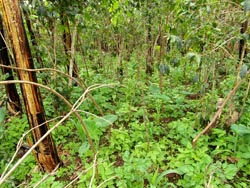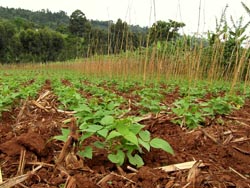Climbing bean can be an important crop for sustainable intensification of cropping systems in the densely populated highlands of eastern Africa. With a potential yield that is approximately two times higher than for bush bean, climbing beans provide an excellent opportunity to enhance bean yields in areas where land is constrained.
From May to August 2014 I conducted my MSc thesis field work in the two main areas with potential for climbing bean cultivation in Uganda, the south-western and eastern highlands. I will explain what type of data I gathered, how this fits within the N2Africa framework and how my results could be used for further research and eventually, for the development of options for improved bean productivity among smallholder farmers in Uganda.
In my study, I compared an area with relatively good market access (Kapchorwa, eastern Uganda) with an area with poor market access (Kanungu, south-western Uganda). I conducted a detailed farm characterization (DFC) in both areas. Building on the work of Reckling (2011)1 and Van den Brand (2011)3. I started with a rapid characterization of 50-75 households in each area to develop a farm typology similar to the one described by Tittonell et al. (2010)2. This farm typology was used to select 16 households in both areas (four per farm type), with whom I conducted the DFC. The DFC was meant to gather a mix of qualitative and quantitative data to describe the current farming systems, main drivers of these systems and opportunities and constraints for improving climbing bean cultivation. In practice this meant that I visited all fields of each farm included in the DFC. I measured field sizes, assessed crop management practices, took soil samples for selected fields and measured important characteristics of climbing beans on fields where they were cultivated (i.e. stake length, stake density, plant density). In interviews I asked each household about labour availability and demand of different crops. I also asked more detailed questions about climbing beans, which could help to explain why households cultivated climbing bean in the way they currently did. At the end of the season I also gathered yield data to relate this to differences in crop management between farmers.
The collected data was used to describe current farming systems and to find possible entry points for improving climbing bean productivity. Main constraints in Kapchorwa were the availability of stakes and, for poorer farm types, land availability. This was a reason why currently 80% of the households cultivating climbing bean did this on a very small area as an intercrop in their banana-coffee fields. Only 20% of climbing bean cultivating households used sole cropping. Farmers cultivating their climbing beans in intercropping had smaller yields than those who grew them as sole crops. The low yields of these small intercropped climbing bean fields could be an entry point for improving climbing bean cultivation. Part of the variation in yields between farms was related to management. For example, higher planting densities were positively correlated with yields. These higher planting densities were two to three times higher than currently advised planting densities. Even though higher sowing densities might not be the ‘best agronomic’ practice, it can be a cheap and easily accessible option for ‘poorer’ farmers. ‘Better-off’ households were more often cultivating climbing bean in sole cropping on larger areas. For these households, options to improve climbing bean productivity would be an increased stake density and better pest control, as these farm types have more cash and land available to invest in climbing bean cultivation.
Currently, only sole cropping of climbing bean is shown in N2Africa demonstrations. Further research on improving management of climbing beans in intercropping systems can be important to improve climbing bean yields for poorer farmers in Kapchorwa.
 |
 |
Two distinct climbing bean cropping systems; smaller area climbing bean intercropped in banana-coffee fields and sole cropping on larger fields by ‘better-off’ farmers. |
Wytze Marinus
1 Reckling M. (2011) Characterisation of Bean Farming Systems Across Farm Types in Northern and Eastern Rwanda - Indentification of Potential Niches for Legume Technologies. Plant Production Systems - N2Africa. Wageningen University Wageningen.
2 Tittonell P., Muriuki A., Shepherd K.D., Mugendi D., Kaizzi K., Okeyo J., Verchot L., Coe R., Vanlauwe B. (2010) The diversity of rural livelihoods and their influence on soil fertility in agricultural systems of East Africa–A typology of smallholder farms. Agricultural systems 103: 83-97.
3 Van den Brand G. (2011) Towards increased adoption of grain legumes among Malawian farmers - exploring opportunities and constraints through detailed farm characterization. Plant Production Systems - N2Africa. Wageningen University & Utrecht University, Wageningen.
